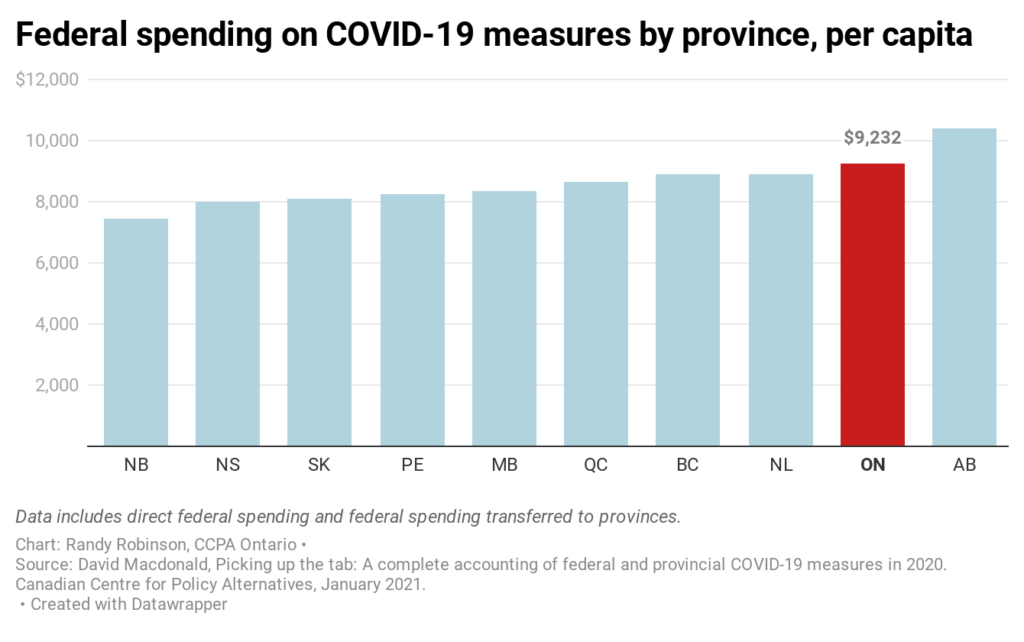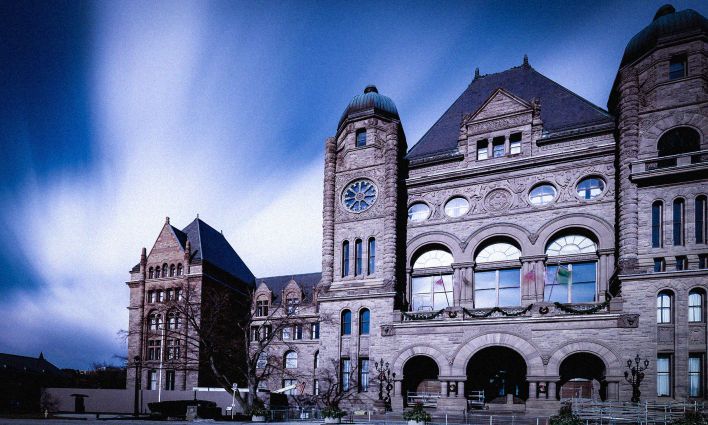Ontario is in a declared state of emergency due to COVID-19.
It should be. As of Jan. 25, COVID-19 had killed at least 5,846 Ontarians, including 3,376 residents and staff in our long-term care homes. More people have now died in the second wave of the virus, which began in September, than died in the first.
You might think that means the provincial government is pulling out all the stops to save lives in the months still to be endured before millions of Ontarians can be vaccinated. At a time like this, you might think Queen’s Park would “spare no expense,” to borrow a phrase from Premier Doug Ford.
You might think that, but you’d be wrong.
When COVID-19 hit, the federal government turned on a firehose of money to fight it. In a new report out today, CCPA senior economist David Macdonald pegs federal pandemic assistance to individuals, businesses, and programs in Ontario at $136 billion in 2020. Put another way, that’s more than $9,200 per person. Only one province—Alberta—has received more federal aid per capita.
But when it comes to spending by provinces, it’s a different story.
Among the six provinces outside the Atlantic bubble, no province has spent less per capita to fight COVID-19 in 2020 than Ontario.
Queen’s Park’s spending of its own money on COVID-19 (not money transferred from the feds) has totalled roughly $9 billion, or just over $600 per person. In percentage terms, the Ford government has picked up the tab for just 6% of overall pandemic spending in the province.
At the end of 2020, the province was holding back $6.4 billion in three different COVID-19 contingency funds. These are funds the province has committed to borrowing and spending, on its own, if things get bad enough.
Well, they’re bad enough. That’s why we’re in a state of emergency.
The areas that are desperate for help are well-known, from essential workplaces to schools to the long-term care sector, where the majority of pandemic deaths have occurred. Yet the Ford government has consistently hesitated in the battle against COVID-19.
“We’re going to continue being very fiscally conservative,” the premier said back in August. On that score, he appears to have kept his word. But at what cost in lives?
Eight months ago today, Ford held a historic news conference in which he released details of a report by the Canadian Armed Forces on “disgusting” (his word) conditions in certain long-term care homes. “Everything is on the table to fix a broken system,” Ford said. “I’ll spare no expense to make sure we fix the system. That’s what we’re gonna do. We’re gonna make sure we fix the system.”
Eight months later, the system’s not fixed. Over 500 long-term care residents and staff in Ontario have already died of COVID-19 in January alone.
Throughout the pandemic, the premier has repeatedly called on the federal government for financial help. In doing so, he has conceded—perhaps inadvertently—that tackling the crisis calls for more spending. But he has not made the case that the federal government has failed to deliver the dollars during the pandemic.
That’s a very difficult case to make.
Federal money has done a lot of heavy lifting in the battle against COVID-19, including in areas of clear provincial jurisdiction like health, education, and municipal services. That does not mean the province can sit idly by as the death toll climbs.
In creating its large contingency funds many months ago, the Doug Ford government apparently imagined how bad COVID-19 could be. But imagination is not enough. Saving lives calls for action, and action now—not next month, not next fiscal year, but now.
History will show that endless delays and half-measures contributed to hundreds if not thousands of deaths that could have been avoided. Sadly, we can’t change the past, and neither can Queen’s Park. But it can change the present, and changing the present means spending money.
Hundreds of lives are hanging in the balance.







